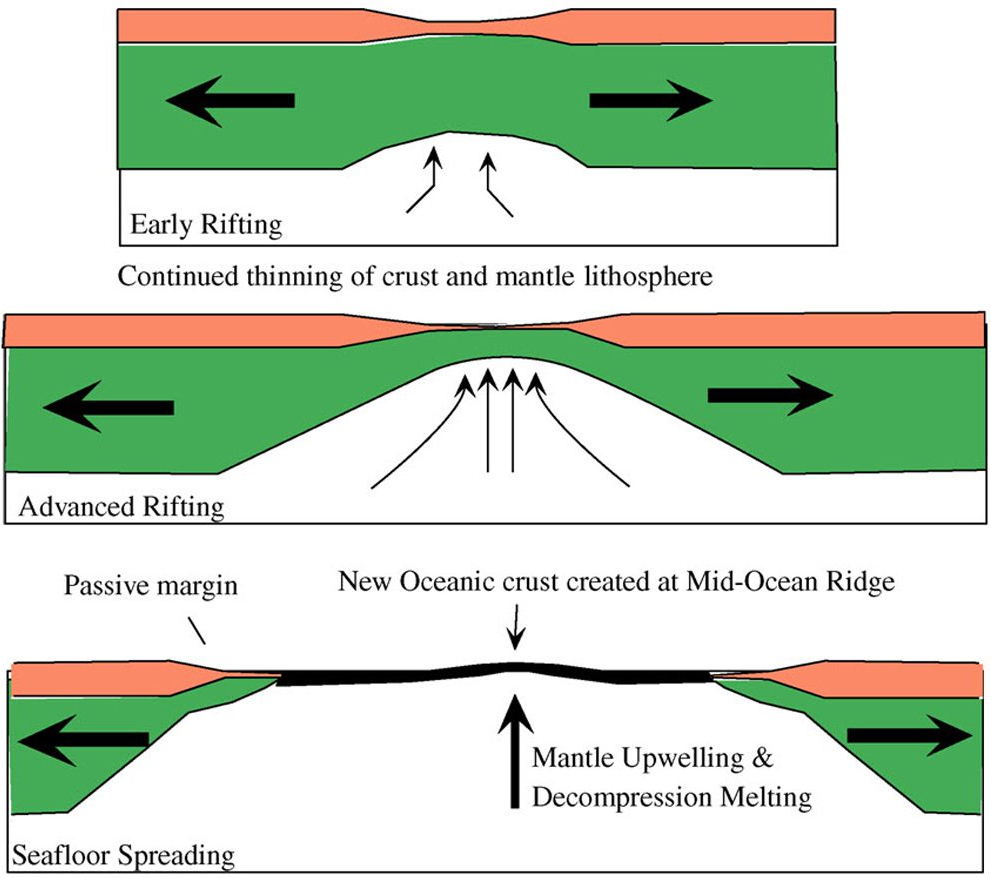Geography
Seafloor Spreading
- 25 Apr 2022
- 5 min read
For Prelims: Seafloor Spreading, tectonic plates, Ring of Fire, Pangea
For Mains: Seafloor Spreading concept and associated geographic features
Why in News?
According to a study that analyzed data from the last 19 million years, Seafloor spreading rates have slowed down by roughly 35% globally.
What are the Highlights of the Study?
- For this study, researchers selected 18 of the world’s largest spreading ridges (mid-ocean ridges).
- A ridge or a mountain ridge is a geographical feature consisting of a chain of mountains or hills that form a continuous elevated crest for an extended distance.
- By studying magnetic records in the rocks on the oceanic crust, they calculated how much oceanic crust had formed over the last 19 million years.
- Basalt rocks on the oceanic crust contain magnetic properties.
- Their magnetism is influenced by the Earth’s magnetic field when the magma reaches the surface and begins cooling to form the crust.
- But the records are incomplete because the crusts get destroyed at subduction zones.
- Subduction zone is a point where two tectonic plates collide, causing one of them to sink into the Earth’s mantle beneath the other plate.
What is Seafloor Spreading?
- The seafloor spreading hypothesis was proposed by the American geophysicist Harry H. Hess in 1960.
- Seafloor spreading is the process of magma welling up in the rift as the old crust pulls itself in opposite directions. Cold seawater cools the magma, creating a new crust.
- The upward movement and eventual cooling of this magma has created high ridges on the ocean floor over millions of years.
- However, the seafloor is destroyed in subduction zones, where oceanic crust slides under continents and sinks back into the mantle, and is reforged at seafloor spreading ridges.
- The East Pacific Rise is a site of major seafloor spreading in the Ring of Fire.
- It is located on the divergent boundary of the Pacific Plate, the Cocos Plate (west of Central America), the Nazca Plate (west of South America), the North-American Plate and the Antarctic Plate.
What are the Reasons behind the Decline of Seafloor Spreading?
- Growing mountains on the continents might be one of the factors driving the slowdown (as it causes resistance to seafloor spreading).
- About 200 million years ago, when the supercontinent Pangea start breaking, there weren’t any major plate collisions or related mountain chains.
- The continents were fairly flat back then.
- Mature Stage of the Supercontinent Breakup: As Pangea progressively broke apart, new ocean basins formed and eventually, the widely fragmented continents started running into each other.
- This happened, for instance, between India and Eurasia, the Arabian Peninsula and Eurasia as well as Africa and Eurasia.
- This is a natural consequence of a ‘mature’ stage of supercontinent breakup and dispersal.
- This happened, for instance, between India and Eurasia, the Arabian Peninsula and Eurasia as well as Africa and Eurasia.
- Changes in mantle convection could also be playing a role as mantle convection transports heat from the earth’s interior to the surface.
- A mantle is a layer inside a planetary body bounded below by a core and above by a crust.
- Mantle convection describes the movement of the mantle as it transfers heat from the white-hot core to the brittle lithosphere.
- The mantle is heated from below, cooled from above, and its overall temperature decreases over long periods of time.
What can be the Impact of Seafloor Spreading?
- Seafloor spreading influences sea level and carbon cycle.
- Seal Level:
- Increasing the rate of seafloor spreading inflates the ridge. Hot, young lithosphere is forming and moving away from the ridge at a faster rate and moving a greater distance from the ridge before it cools and contracts. So sea level rises.
- Carbon Cycle:
- Faster rates mean more volcanic activity, which injects greenhouse gases into the atmosphere.
- Seal Level:





